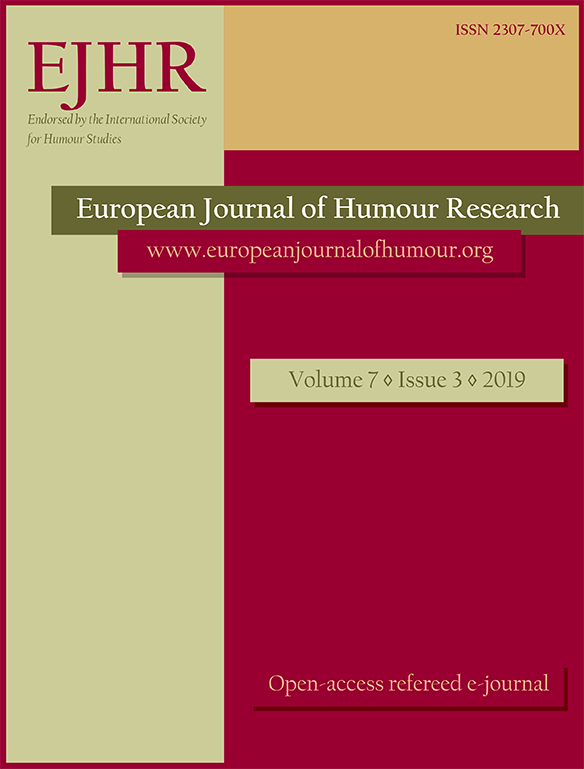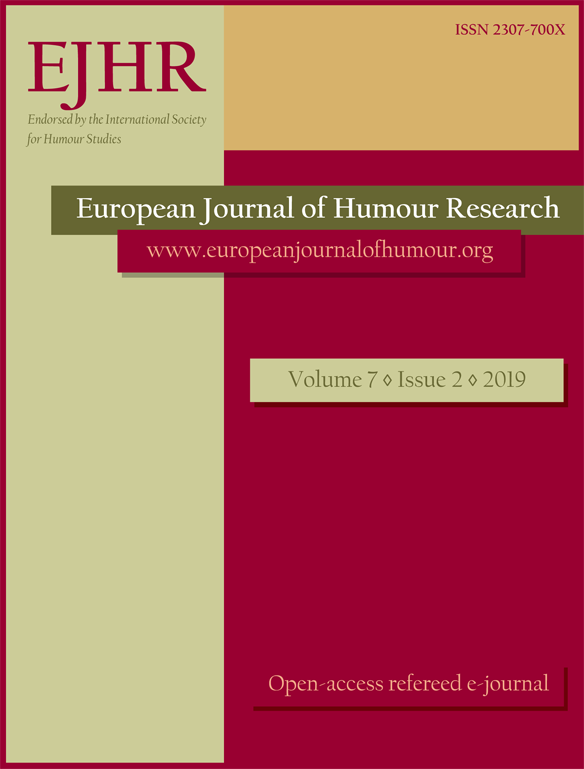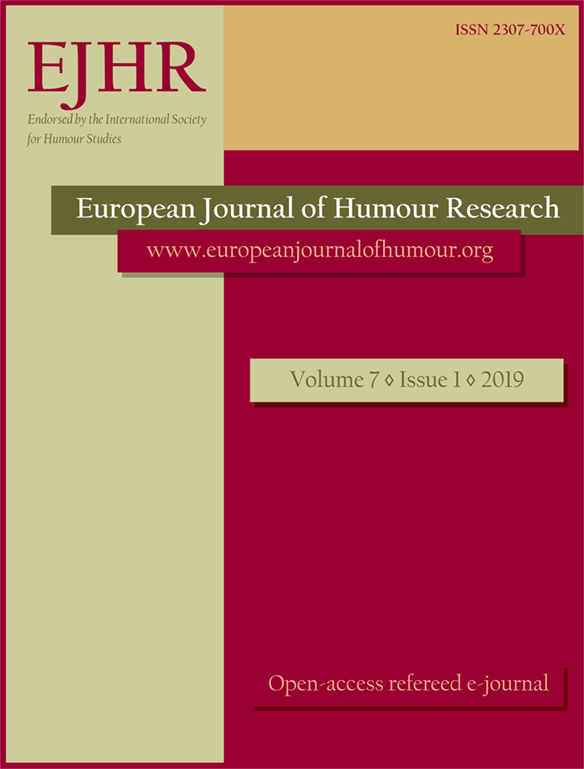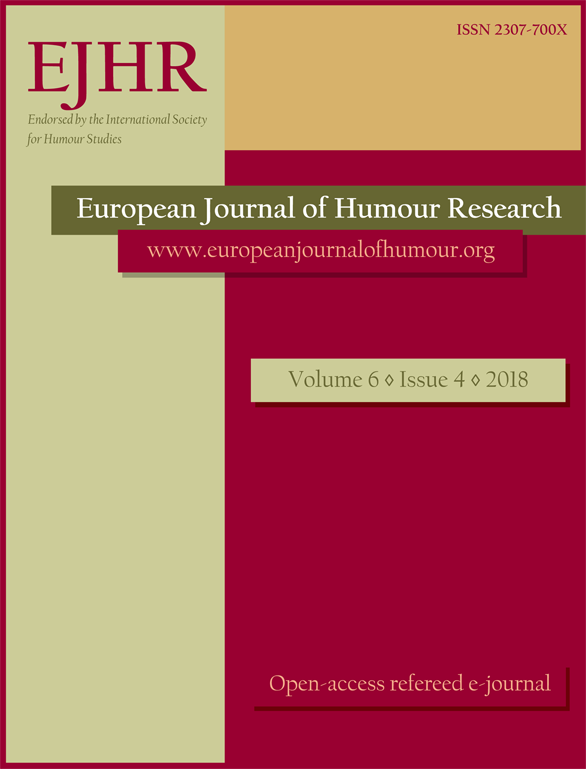
We kindly inform you that, as long as the subject affiliation of our 300.000+ articles is in progress, you might get unsufficient or no results on your third level or second level search. In this case, please broaden your search criteria.


This paper assesses the results of a multimodal analysis of humorous instances found in a collection of 14 interviews from The Late Show with Stephen Colbert. The interviews have been imported and annotated in ELAN for head movements and face gestures. Only the interviewees’ remarks are studied in order to ensure the analysis of spontaneous speech, avoiding mostly pre-scripted host’s comments and questions. The results demonstrate that there are no gestures consistently and recurrently paired with humour. Therefore, none of the multimodal cues found in the sample can be considered markers of humour. Furthermore, the functions of gestures identified are consistent with the uses reported in previous multimodal studies of humorous and non-humorous communication found in the literature.
More...
This research aimed to explore gender stereotypes depicted in online sexist jokes collectedfrom laughfactory.com. Linguistically speaking, jokes as a subtype of humour have become acommon phenomenon in our everyday lives. Unfortunately, not all jokes can bring positivevibes for everyone. Yet, these forms of jokes are still commonly found, especially on theInternet. Some online sources, including websites of jokes, present a lot of collections of jokesfor fun, but a number of the jokes are categorized as sexist jokes, which might also beregarded as offensive in a certain context. Data were collected from the laughfactory.comwebsite and then were analysed by using the three-dimensional model of Critical DiscourseAnalysis (CDA) and the General Theory of Verbal Humour (GTVH). Results showed that themajority of the jokes observed were targeted at women (90%) and a small number wastargeted at men (10%). Women were stereotyped as sexual objects, emotionally expressivebeings, homemakers, being talkative, being stupid or brainless, and belonging to a lower classthan men. Men, on the other hand, were stereotyped as worse than women.
More...
The aim of this paper is to examine Eva Hache’s humorous gender-related monologues,broadcast in the show El Club de la Comedia [The Comedy Club] in Spain between 2012 and2013. The corpus comprises 24 stand-up monologues, which have been analysed bothquantitatively and qualitatively. The present paper offers a case study in three different ways.First, an analysis of different humorous sequences makes it possible to distinguish arepresentation of both feminine and masculine identities, as well as a confrontation betweenthe two genders. In fact, Eva Hache’s style supports the feminine identity and facilitates theteasing and mockery of men. Second, a polyphonic study of men as speakers (locutors) andutterers (Ducrot 1996) will serve to differentiate certain features of their identity from adiscursive perspective. Finally, a detailed examination of humorous sequences shows howthese performative sequences can prove useful to maintain hierarchy, to reinforce an in-group,i.e. a women’s group, to solidify men’s group boundaries, and even to subvert gendernormativity (Bing 2004). As it will be demonstrated in our analysis, humorous markers andindicators play an important role in the construction of jab lines and the final punch line ofthese sequences. Furthermore, the results show that there are few strategies aimed atchallenging the status quo in this corpus, although they illustrate an ongoing movementtowards a feminist humour that has been almost non-existent in Spain so far.
More...
Humour is a phenomenon that is pervasive in the human heritage in all its different ethnic andcultural diversity; however, humorous effects might exceed the mere pleasure or laughter toserve as a strategy of survival. Hybrid humour has an important societal role in breakingpsychological barriers between people as well as in denouncing dominant discourses,criticising realities, and promoting resistance. This paper investigates hybrid humour ascultural translation, particularly Beur verbal humour in France. The first section of this paperexplores the notion of cultural translation. The second part is devoted to investigating thehybridisation of cultures from a postcolonial perspective, and subsequently interpreting thenotion of hybrid humour as a translational act. Finally, I analyse a set of hybrid jokes made bythe Franco-Algerian humourist Fellag.
More...
Nigerian humourists have always told risible jokes within myriad pre-colonial satirical acts.Following on their heels in recent times, stand-up comedy has emerged as one of the mostprevalent art forms in the country, providing entertainment through laughter-eliciting jokes.Accompanying this development also, is an increasing attitude of offence-taking which hasseen post-mortem criticisms and castigation of comedians. Not much scholarly attention hasbeen paid to this menacing backlash against ostensible “inappropriate jokes” and the fact thatstand-up humour is primarily derived from causing offence. What happens is that jokeperformances take place within liminal moments, which allows for audience’s suspension ofoffence and the performer’s unwritten consent to stay within socially accepted bounds of goodhumour. Through performance analysis, this paper sets out to study how four randomlyselected Nigerian comics—I Go Dye, Basket Mouth, Klint da Drunk and AY—deploy selfcensorshipin averting offence within their joke routines. The essay finds that despite thespecificities of stand-up arts, which place peculiar demands on artists’ joking capabilitiesespecially in its dependence on courting audiences’ participation and familiarity, thesecomedians have devised specific means through which they circumvent the stringency ofeliciting mirth through insult. Hence, their jokes and those of others who have learned theirtrade well, often elicits hilarity rather than offence.
More...
The context for the paper is the inclusion of a 64-year old cartoon in the Political Sciencetextbook that caused an uproar in the Indian parliament in 2012. The controversy drawsattention to the two-facedness of any political cartoon which is an artistic representation of ahistorical event. It is, hence, ambivalent by being an expression of artistic freedom as well asa humorous comment on history where the axis of representation intersects the axis of history.The representation of the Dalit icon, Ambedkar, was objectionable to the political partyespousing the Dalit cause which, through its leader, Tirumavalavan, raised the issue inparliament. The paper posits that the reaction was an event that was hitherto dormant andthat it erupted on account of elements that fed its potential for virality in the environment,thereby, turning it into a fact. To this end, the paper revives interest in the imitation theory ofthe French sociologist, Gabriel Tarde, who, incidentally, was an intellectual influence onAmbedkar. Moreover, it employs Zeno Vendler’s distinction between an “event” and a “fact”,the Deleuzian idea of “assemblage,” and the idea of “conceptual metaphor” as laid out byLakoff and Johnson. The paper reads the vicissitudes of the cartoon in order to theorize theelements that cause virality in a communicative environment.
More...

This paper examines the work of Billy Wilder whose rich cinematic production frequentlyinvolves the collision of different languages as well as the clash of dissimilar cultures. As anAustrian living in the USA, the director had the privilege of gaining insight into his adoptedculture from the point of view of an outsider – a bilingual “other” who made 25 films inalmost 40 years of working in Hollywood. His films recurrently depict foreign characters atwhich Wilder pokes fun whether they are English, French, German, Italian, Russian or eventhe Americans of his adopted country. More precisely, the paper offers an overview of themulti-modal portrayals of diverse “foreigners,” with examples taken from a small butsignificant sample of Wilder’s films. The subtitling of dialogue in the secondary language forthe target English-speaking audience and the specific translation solutions are not within thescope of this discussion, instead we focus on the comic collision of two languages and moreimportantly, on the way Wilder implements humour to highlight the absurdity of culturaldifference. In other words, our main goal is to explore two or more languages in contrastwhen they become a humorous trope.
More...
A heterolingual text is characterised by the presence of two or more different languages, or two or more varieties of the same language (Corrius & Zabalbeascoa 2011: 115). This article discusses possible methods of translating into English of a text containing two varieties of German: Ottokar Domma’s Der brave Schüler Ottokar [The Good Schoolboy Ottokar]. In these stories, about a schoolboy growing up in the German Democratic Republic (GDR) in the 1960s, Domma creates a zone of friction between child narrator Ottokar’s everyday German and the language of GDR officialdom (“official discourse”). This article first shows that following a conventional method of translating a literary text into English does not allow this satire to be conveyed to the reader. It then presents two alternative translational methods — “thick” and creative — that demonstrate how it is helpful, indeed in some cases necessary, for the translator to adopt a broad understanding of “translation” in respect of texts that exploit multilingualism for humorous purposes. It is argued that methods of translating in which effect is privileged over form — which here included introducing multimodality — can serve well to open up heterolingual humour for speakers of other languages.
More...



The narrative pattern and discursive strategies of stand-up comedy in Nigeria reveal sometropes and motifs that are contemporary to the socio-political realities of the country. Thesenarrative/discursive strategies demonstrate three discourse types: salutation/greetingdiscourse, reporting discourse, and informing discourse. With these discourse types, stand-upcomedians use themselves as the victims of the jokes in order to evoke laughter in the audience.The performances of stand-up comedy, however, have not been accorded due recognition ofthe functional arts that can be used to critique the failure of the ruling elite in the NigerianState. This is because stand-up comedy is class-selective and occasion-driven. To evokelaughter in the audience and to comment on the reality of existence, stand-up comediansdeploy language aesthetics, kinesics, and atmosphere. The modal transition from pure oralstage to the technological phase of performance informs the conceptualisation of mediamediated performance (MMP) through recorded VCDs/DVDs and social media. Data on thestand-up comedy of AY and Elenu are collected through media mediated performances (MMP)on VCD. Data on the subject matter, topicality, and discursive strategies of AY and Elenu’s(who are among ace stand-up comedians in Nigeria) jokes are analysed and discussed. Withthe subject matter and topicality of the jokes, this paper suggests that stand-up comedyperforms the utilitarian functions of literary and performing arts. It entertains, moralises,satirises, and educates members of heterogeneous audiences on some values and ethos of thecontemporary Nigerian society.
More...
Masking is a phenomenon that is traced to almost all human ages, from its prehistoric andprimitive narratives in Africa, its dramatic beginnings in ancient Greece and Rome, to its useas forms of character delineation in the commedia dell’Arte of the 16th and 18th centuryEurope, as well as its age long association with carnivals due largely to its analogous relationto humour and entertainment. Masking, as comic as it may seem, has been critical ofhumanity’s social dispositions from time past. As humans, the façade of the mask is a leewayto speak truth to power and also an opportunity for the performance of self in ways that are atvariant with the real self. As topical as the activities of the masquerade are to the society, noacademic quest has been directed to investigate how humour and satire have always beenassociated with the masquerade. Following the social criticism, humour and entertainmentwhich have become evidently inherent in the emergent stand-up comedy, scholars havedirected their critical attention towards this new live theatre without considering thehumorous functions of the masquerade for an academic enquiry. It is against this backdropthat this paper has decided to investigate and re-establish historically the humorouscontributions of the masking art in almost all facets of human conditions. The resources forthe paper are a combination of library and historical research. The paper establishes thatsatire and humour, as enjoyed in all venues of stand-up comedy acts in Nigeria, are just acontemporary addition to what masks had done in the past but for dearth of properdocumentation of these contributions. The masking tradition has been a source of humour andsarcasm to issues bordering on human relations all over the world.
More...
Studies in stand-up comedy in Nigeria have recently begun to gain serious attention. Several articles that describe the psychological and socio-cultural contexts of joke texts of stand-up comedy in Nigeria have appeared within the last few years (Orhiunu 2007; Imo 2010;Adetunji 2013; Filani 2015, 2016, among others.). However, one aspect of the phenomenon that is yet to be explored is the function of a multimodal generic framework and its contributions to the humorous content of the genre. While it is important to maintain the spoken text as many writers have done, the “multiple embodied modes” (Norris 2008: 13) that amplify the spoken text must be given due consideration. This study, therefore, examines the Nigerian stand-up comedy from the perspective of a multimodal-ESP theory to genre analysis.This theory takes cognisance not only of joke-texts, but also of the visual features that enhance the performance. The material for analysis is videoed data of a popular stand-up comedy show in Nigeria, A Nite of a Thousand Laughs. The study demonstrates that stage management, nonverbal cues (e.g. gesture, movements, and gaze), speeches, body postures, and music/sounds contribute to the communicative value and the production of the genre. Also, it shows how plausible multimodal-ESP approach to genre is in the description of stand-up comedy in the Nigerian context.
More...
Various studies exist on the social functions of humour and such studies have been carried outin diverse fields that range from the humanities to the sciences. In linguistics, specifically,research shows that humour has been studied from the perspectives of syntax, pragmatics, andsemantics; moreover, there is a dearth of studies on the creation of humour throughphonological processes. Therefore, this study aims to investigate humour and how it isachieved using phonological processes. The study engages mainly qualitative methods ofanalysis. Five comedy skits were purposively selected from Folarin Falana’s (Falz the BahdGuy) eleven collections. These were chosen on the basis of their internet popularity amongNigerians; this popularity was determined on the basis of the rates of downloading the skits.McGraw & Warren’s (2010) Benign Violation Theory was used to account for thephonological violations in the comedies. The various phonological processes that wereviolated include liaison, deletion, insertion, monophthongisation, coalescence, and vowelstrengthening. It is argued that the phonological distortions are deliberately made to achievehumour in these Nigerian comedies, especially when the high educational level of the artist isconsidered. Also, there anti-Anglicism and pro-Nigerianism in the data as the artist identifieshimself with Nigeria(ns) and creates a niche for himself in the entertainment industry usingthe phonological peculiarities among Nigerians’ language use, especially the Yoruba tribe. Healso creates different personalities to project different messages which are not only peculiar toNigeria but to the world, using these personalities to portray people’s feelings and views ofthe world and how these influence their attitudes.
More...
Internet memes significantly constitute an outlet for extensive popular political participation in election contexts. They instantiate humour and represent political candidates so as to affect voters’ behaviour. Few studies on memes in political context exist (Shifman et al. 2007; Chen 2013; Tay 2014; Adegoju & Oyebode 2015; Huttington 2016; Dzanic & Berberovic 2017). These studies have not intensively examined the integrative deployment of visual and verbal resources afforded by internet memes to generate humour and to construct specific frames for election candidates in the campaign context of an emerging democracy. Therefore, this study investigates the use of language and visuals for humour generation and for the creation of definite frames for the two major presidential candidates in internet memes created in the course of the 2015 Nigerian presidential election campaigns. The theoretical insights for the study are derived from Attardo’s (1997) set-up-incongruity-resolution theory of humour, Kuypers’ (1997, 2002, 2009, 2010) model of rhetorical framing analysis, Bauman & Briggs’ (1990) concept of entextualisation, Kress & van Leeuwen’s (1996) socio-semiotic model for visual analysis and Sperber & Wilson’s (1986) relevance theory. The analysis indicates that meme producers generate humour and frame candidates through the entextualisation of verbal and visual texts, explicatures and implicatures. The memes construct seven individuated frames and one collective frame for the two major presidential candidates in the sampled memes using visual and linguistic resources. It concludes on the note that supporters of election candidates use humorous internet memes for negatively portraying opponents and for positive representation of the favoured candidate. These negative other-representations serve the purpose of depreciating the electoral values of the opponents and indirectly increasing the electoral chances of their own candidates.
More...
This article explores the deployment of humour in Wole Soyinka’s new and full-length play Alápatà Apátà. The emergence of Moses Olaiya (otherwise known as Baba Sala) on the Nigerian theatre scene at a time it was dominated by such colossuses as Hubert Ogunde, Duro Ladipo, and Kola Ogunmola, as a popular jester and comic actor has elevated the phenomenon called Zd to a popular form of art. The idea of serious theatre involving mostly tragedy had dominated the Nigerian theatrical scene to an extent that little attention is devoted to the less popular form of comedy until it was given impetus by the dexterity of Moses Olaiya. In the dramatic literary circle, Wole Soyinka bestrides the Nigerian space with his biting and humorous satire in such plays as The Lion and the JeZel, The Jero Plays, Childe International amongst others. With a great mastery of satire and humour, in his most recent play Alpat Apt, we witnessed a reincarnation of Moses Olaiya. However, Soyinka does not focus only on the character of Moses Olaiya (whom he dedicates the play to), he explores the misapplication of Yoruba language’s accent resulting in semantic oddity. The incongruity that can arise from the misunderstanding of language and its nuances is brought to the fore in our understanding of the theoretical exploration of the phenomenon called Zd. This article thus situates Wole Soyinka’s Alpat Apt within the literary and theatrical explication of humour in the Nigerian context showing that ‘that which is comic’ resonates as a universal human phenomenon irrespective of language.
More...